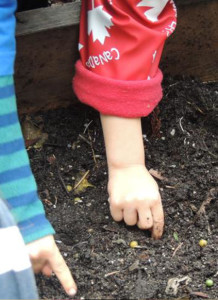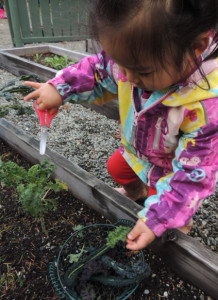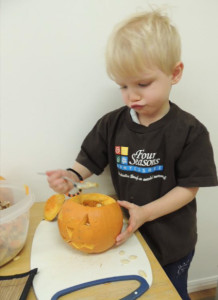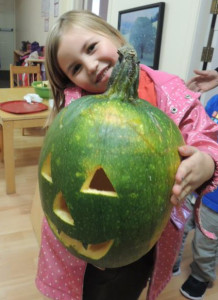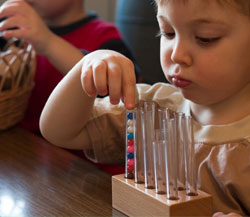Planning and Planting
On Earth Day, during the spring of last year, the children, families and teachers at Four Seasons Montessori gathered together to plant flowers, vegetables, herbs and fruiting plants in the school garden. A new tin-roofed pavilion, flower boxes, a greenhouse, and raised planter boxes had been built and stood ready to go; it was an exciting day of activity and shared effort.
Growth and Observation
Over the following months and throughout the hot summer days, the children watered and watched the plants grow. The watermelon vines crept over and around the bushy kale and the heads of lettuce. The strawberry plants and blueberry bushes produced sweet morsels to eat. There was always a constant array of colourful flowers on display.
Harvesting and Education
By the fall season of the present school year, the returning children, who are now 4 and 5 years old, and a little taller and wiser, discovered a large pumpkin growing in the garden. They identified the parts of the plant, from the curly tendril perched atop the stem, to the rind that was beginning to turn from a glossy dark green to a bright orange hue. The children carried the seasonal squash inside to dissect and name the parts of the large gooey cavity. They carved a classic Halloween face and their pumpkin became a Jack-o-Lantern.
Decomposition and Wisdom
In early November it was time to take the pumpkin back out to the garden to decompose. It melted away into the soil and lots of laughter could be heard each day during playground time as the happy face gradually drooped, making funny expressions.
The Three-Year Cycle
This was a new experience for many of the children, to measure their growth and development in parallel with the life cycle of the plants:
The 3 year-olds, who are in the stage of discovery and awakening of their true potential, saw life explode from the seeds they poked into the soil. The 4 year-olds, who are in the period of exploration and imagination, experienced the dramatic change of a seedling into a plant bearing fruit. The 5 year-olds, who are gaining the strength and wisdom of the final period, washed, dried and stored the new seeds for planting next spring, completing the cycle of life.


